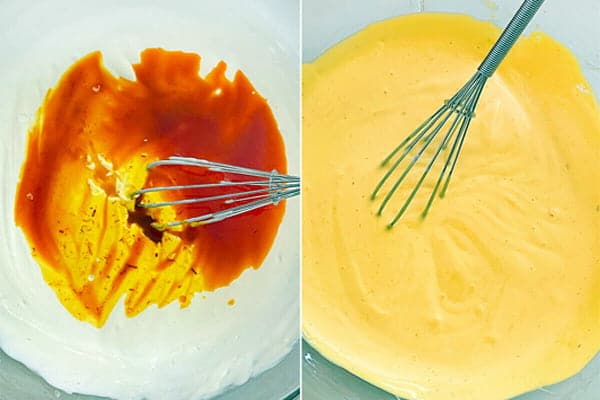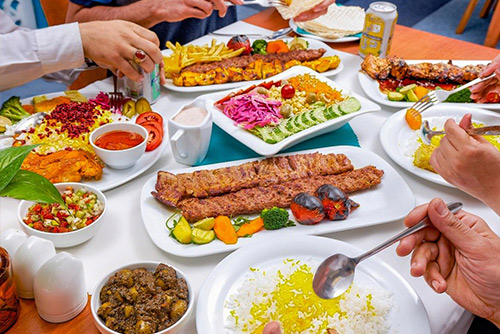
Tahchin literally means “arranged at the bottom” and refers to a layer of rice combined with meat to form a thick tahdig. Traditionally the rice is mixed with egg in addition to yogurt. Tahchin can be made with chicken or tender cuts of lamb; the chicken version is more popular and easier to make.
There are also some vegetarian versions with spinach or aubergine/ eggplant. This recipe is reasonably easy and the result is quite impressive.
The thick Greek-style yogurt binds the rice together with the meat and when cooked in a heavy-based non-stick pan or a non-stick rice cooker you can turn it out like a cake onto your serving dish.
Serves 4–6
Preparation: 25 minutes,
plus soaking
Cooking: approximately 2 hours

Contents
Ingredients
- 600 g/1 lb 5 oz basmati rice
- 4 tablespoons salt
- 8 chicken pieces (preferably thighs)
- 1 large onion
- 4 tablespoons vegetable oil
- ½ teaspoon turmeric
- 3 tablespoons lemon juice
- 6 tablespoons liquid saffron
- salt and black pepper
- 500 ml/just under 1 pint water
- 50 g/2 oz butter
- 400 g/14 oz Greek-style full-fat/
- whole milk yogurt
- 1 egg (optional)
Preparation
Wash the rice and soak for 2 hours.

Cooking chelo and polo (traditional method)
Drain the soaked rice. Fill a saucepan three-quarters full with cold water. Add 1 tablespoon of salt per 300 g/11 oz of rice. Bring to the boil on a high heat. Add the rice to the boiling water. To begin with, you will see individual grains of rice rising to the surface as the water boils.
Gradually, more grains come up to the surface with each bubble. After about 10 minutes, you will see the pattern of bubbles change to waves of rice rising to the top. Count approximately five waves and then remove from the heat. Drain in a fine-meshed colander or a large sieve. Taste a couple of grains. If the rice is too salty, rinse once with cold water.
The rice is now ready for steaming. At this stage you can add other ingredients if you are making a polo. Return the empty saucepan to the heat and add vegetable oil (or oil and butter; follow the recipe).
Add your chosen tahdig ingredient . Reduce the heat and gently pile the rice on the tahdig, using a slotted spoon and starting from the middle of the pan. Ideally, you will end up with a pyramid of rice that comes short of touching the lid. This will allow the steam to escape from the sides as well as the top, leaving your rice grains separate and fluffy. Drizzle vegetable oil – or oil and butter cut into small pieces – over the top.
Wrap the lid in a clean tea towel and put it firmly on the pan to prevent steam from escaping as much as possible. The cloth also absorbs the condensed steam on the lid, preventing it from dropping back into the pan and making the rice soggy.
Reduce the heat to low, but make sure that steam rises all the way to the top of the pan. If you have a gas hob, reduce the heat to minimum and use a heat diffuser. Leave to steam for 45 minutes to 1 hour (follow the recipe). It is advisable not to remove the lid during steaming; the crust will form nicely and the rice will not burn. The lid should be hot to the touch and the tea towel should be moist with the steam.
Trim and wash the chicken thighs, remove the skin and bones, and pat the meat dry on kitchen paper. Peel and roughly chop the onion.

Cooking
Use a heavy-based saucepan, preferably non-stick, large enough to allow the rice and chicken pieces to be steamed together. Heat 2 tablespoons of oil and fry the onion until golden. Add the chicken pieces and turmeric and stir well to seal the chicken on all sides. Add the lemon juice and 2 tablespoons of liquid saffron and season with salt and pepper. Reduce the heat, cover the pan and cook the chicken for approximately 30 minutes. When the chicken is cooked through, remove the pieces with a slotted spoon and set aside. Reserve the cooking juices in the pan.
Pour 500 ml/just under 1 pint of water into the pan with the chicken cooking juices. Add 1 tablespoon of salt and bring to the boil. Drain the rice and add to the pan with 1 tablespoon of oil and half of the butter. Simmer gently until all the water has been absorbed and small holes start to appear in the surface.
Mix the rest of the liquid saffron with the yogurt. Fold the saffron yogurt mixture and the chicken pieces into the rice, making sure that the chicken pieces are coated with the saffron yogurt.
Reduce the heat to a minimum (on a gas flame use the lowest setting and a heat diffuser), add the rest of the butter and the oil. Wrap the lid in a clean tea towel and place on the pan. Leave to steam for 1 hour.
Remove from the heat and stand the pan in 5 cm/2 inches of cold water for 1–2 minutes to loosen.
Heat the oil in a heavy-based saucepan, preferably cast-iron, and toss the quartered onion in the oil for a couple of minutes, until lightly golden. Add the lamb shanks and turn to seal on all sides. The meat should not be browned at this stage.
Add the turmeric and stir to coat the shanks evenly. Drain the split peas and add to the pan, then add the dried limes.
Pour the boiling water into the pan and stir well. Bring back to the boil, then reduce the heat and cover the pan with a lid. Simmer gently for approximately 1½ hours until the shanks are nearly cooked (you should be able to separate the meat from the bone with a fork) and the split peas are al dente. Keep the heat low and keep the lid on the pan to retain as much of the liquid as possible.
Drain and add the potatoes and the tomato purée/tomato paste to the pan and stir to mix. Leave to simmer very gently until the potatoes are cooked, approximately 30 minutes. Season to taste.
Add the red kidney beans and simmer for a further 10–15 minutes. Add the lemon juice and simmer for another 5 minutes. Just before serving, add the liquid saffron and mix well.
Serve with warm flat bread such as pitta or lavash (very thin Persian bread) with a side dish of yogurt and fresh herbs.

Essential Tips for Cooking Chicken Tahchin
Chicken Tahchin is a unique culinary gem among Iranian dishes, capturing unparalleled aroma and color after cooking. Here are some golden tips to elevate the taste and quality of your Chicken Tahchin:
1. Opt for Boneless, Skinless Chicken Breast
Ensure that the chicken breast you’re using is devoid of skin and bone. This will contribute to a cleaner, leaner flavor and texture.
2. Use Authentic Iranian Rice
For the best aromatic and flavorful Tahchin, always go for authentic Iranian rice. Its grains are perfect for absorbing the spices and delivering that classic Persian taste.
3. Employ the Ice Technique for Saffron
If you have ample time, use ice to extract an excellent color from saffron. Place ground saffron and ice in a sealed container overnight. After the ice melts, add a bit of boiling water to the mix. Store this saffron solution in the refrigerator for use.
4. Utilize Only Egg Yolks
This recipe requires only egg yolks, leaving you with egg whites that you can use for making an omelet or another dish.
5. Choose High-Quality Yogurt
The thicker the yogurt, the more it enhances the Tahchin’s flavor and texture. Thick, creamy yogurt is highly recommended for the best results.
6. Opt for Odorless Olive Oil
You can replace olive oil with cooking oil if you prefer. However, if you’re using olive oil, go for the odorless variety so it doesn’t overpower the dish’s other fragrances.
7. Low Heat and Proper Sealing for Stovetop Cooking
If cooking the Chicken Tahchin on a stovetop, always set the flame to its lowest setting. Use a flame diffuser and cover the pot with foil to keep in the moisture. The maximum cooking time on the stovetop should be up to 1 hour.
Best Way to Reheat Chicken Tahchin
Reheating Chicken Tahchin can be a bit of an art to preserve its original texture and flavors. While you can easily use a microwave, heating it on a stovetop offers better results for this delectable Persian dish.
Using Stovetop Method
If you’re warming up the Chicken Tahchin on a stovetop, start by covering the bottom of a pot with a moist cloth or paper towel. Add half a tablespoon of oil and a small layer of white rice at the bottom of the pot. Place the leftover Chicken Tahchin on top of this layer. Set the heat to medium and let it cook for up to 15 minutes.
By doing so, you not only warm the dish but also revitalize its authentic flavors and textures. The cloth or paper towel helps maintain the moisture, while the layer of oil and rice at the bottom prevents sticking and even adds a little extra flavor.
Remember, reheating times may vary depending on the thickness of the Tahchin and the heat of your stovetop. Always check the middle part to make sure it’s fully reheated before serving.
Nutritional Value of Chicken Tahchin
Chicken Tahchin is known for its suitable amount of protein and calories, making it a nutritious meal that is also flavorful and aromatic. Below is a table that reviews the nutritional value per 100 grams of this dish:
| Nutrient | Amount |
|---|---|
| Calories | 193 kcal |
| Total Fat | 8 grams |
| Cholesterol | 103 milligrams |
| Sodium | 192 milligrams |
| Carbohydrates | 18 grams |
| Fiber | 0 grams |
| Sugar | 4 grams |
| Protein | 12 grams |
Read More
Source: New Persian Cooking: A Fresh Approach to the Classic Cuisine of Iran by Jila Dana-Haeri





